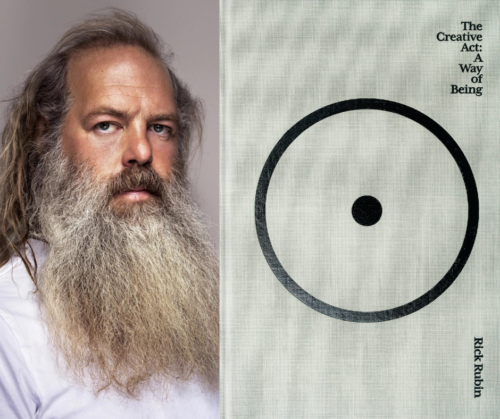
Rick Rubin is a nine-time GRAMMY-winning producer, named one of the 100 most influential people in the world by Time and the most successful producer in any genre by Rolling Stone. He has collaborated with artists from Tom Petty to Adele, Johnny Cash to the Red Hot Chili Peppers, Beastie Boys to Slayer, Kanye West to the Strokes, and System of a Down to Jay-Z.
Rubin approaches creativity to show what works…and what doesn’t. Rubin’s lessons apply to every aspect of creativity— whether music, writing, painting, or, as Rubin says, even more pragmatic situations, such as starting a business, or solving personal problems. The Creative Act is as much a guide to life as it is a guide to art. In a series of short, pithy chapters, Rubin focuses on all the elements of the creative process and how they should be used and improved.
I was impressed by Rubin’s warnings about common mistakes in the creative process:
- Clinging to rules or guidelines that may stifle the childlike creative impulse.
- Trying to imbue art with too much intention rather than respecting a work of art’s own natural unfolding. The ultimate purpose or destiny of a work of art is almost never clear to the artist.
- Competing with collaborators, or other artists or creatives, rather than nurturing one’s own voice.
- Forcing art. The more it is forced, rather than allowed to unfold naturally, the more it loses its innate character.
- Prioritizing the criticisms or voices of others, rather than oneself and staying true to the work of art.
- Focusing on commercial outcomes— this can lead to a work of art that feels more artificial or compromised, and will likely not be as successful as it could be.
- Aspiring to perfection. There are no objective measures for the success or purpose of a work of art, and to obsess over achieving perfection is to play a game you can’t win — in fact, sometimes art that is flawed can be more emotionally resonant than something that is “flawless.” It’s a bit of a paradox. Even flawless art contains a flaw, that of a lack of humanity.
If you want to understand and enhance your creativity, check out Rick Rubin’s THE CREATIVE ACT: A WAY OF BEING. Highly recommended! Where does your creativity come from? GRADE: A
TABLE OF CONTENTS:
Everyone is a creator — 1
Tuning in — 5
The source of creativity — 13
Awareness — 19
The vessel and the filter — 25
The unseen — 31
Look for clues — 37
Practice — 43
Submerge (the great works) — 49
Nature as teacher — 51
Nothing is static — 55
Look inward — 59
Memories and the subconscious — 63
It’s always there — 67
Setting — 69
Self-doubt — 73
Make it up — 77
Distraction — 85
Collaboration — 89
Intention — 93
Rules — 97
The opposite is true — 107
Listening — 109
Patience — 113
Beginner’s mind — 117
Inspiration — 127
Habits — 133
Seeds — 143
Experimentation — 149
Try everything — 157
Crafting — 163
Momentum — 169
Point of view — 177
Breaking the sameness — 183
Completion — 191
The abundant mindset — 201
The experimenter and the finisher — 205
Temporary rules — 207
Greatness — 215
Success — 219
Connected detachment (possibility) — 225
The ecstatic — 229
Point of reference — 235
Non-competition — 237
Essence — 241
Apocrypha — 247
Tuning out (undermining voices) — 253
Self-awareness — 257
Right before our eyes — 263
A whisper out of time — 269
Expect a surprise — 273
Great expectations — 277
Openness — 283
Surrounding the lightning bolt — 289
24/7 (staying in it) — 295
Spontaneity (special moments) — 299
How to choose — 305
Shades and degrees — 309
Implications (purpose) — 313
Freedom — 317
The possessed — 323
What works for you (believing) — 325
Adaptation — 327
Translation — 331
Clean slate — 335
Context — 339
The energy (in the work) — 343
Ending to start anew (regeneration) — 349
Play — 353
The art habit (sangha) — 359
The prism of self — 363
Let it be — 369
Cooperation — 371
The sincerity dilemma — 379
The gatekeeper — 385
Why make art? — 391
Harmony — 397
What we tell ourselves — 403
I get my creativity through a mail order catalog, but by the time it arrives, it’s been damaged in shipping.
Jerry, I remember when we used to get the SEARS catalog in the mail. The whole family ordered something from it!
George, when the Sears catalog came in, it was an important event; we each had to stand in line to see who would get it next. Oh, the wonders contained in those pages…
Jerry, there used to be “catalog” stores like SEARS in our area. They all folded in the past 20 years. The end of an era…
So why is he giving me the stink-eye?
Dan, I think Rick Rubin wants you to be more creative.
I’m like Jerry, but mine was lost in the mail.
Jeff, the only catalogs we get now are from J Jill, Talbots, and other clothing companies. And, they’re all for Diane.
No Sears, but for years Jackie got the Spiegel catalogue. They folded in 2019.
Jeff, we received Spiegel catalogs for years. Then…they were gone.
I do dislike beards like this. David Letterman’s make him look a hundred years old. The book sounds interesting though.
Patti, I grew a beard in college and found out how much I didn’t like it.
The nice thing is that by reading this book you will change your life for the better! It works every time, which is why there are new how-to books coming out every week!
Bob, and they continue to sell well!